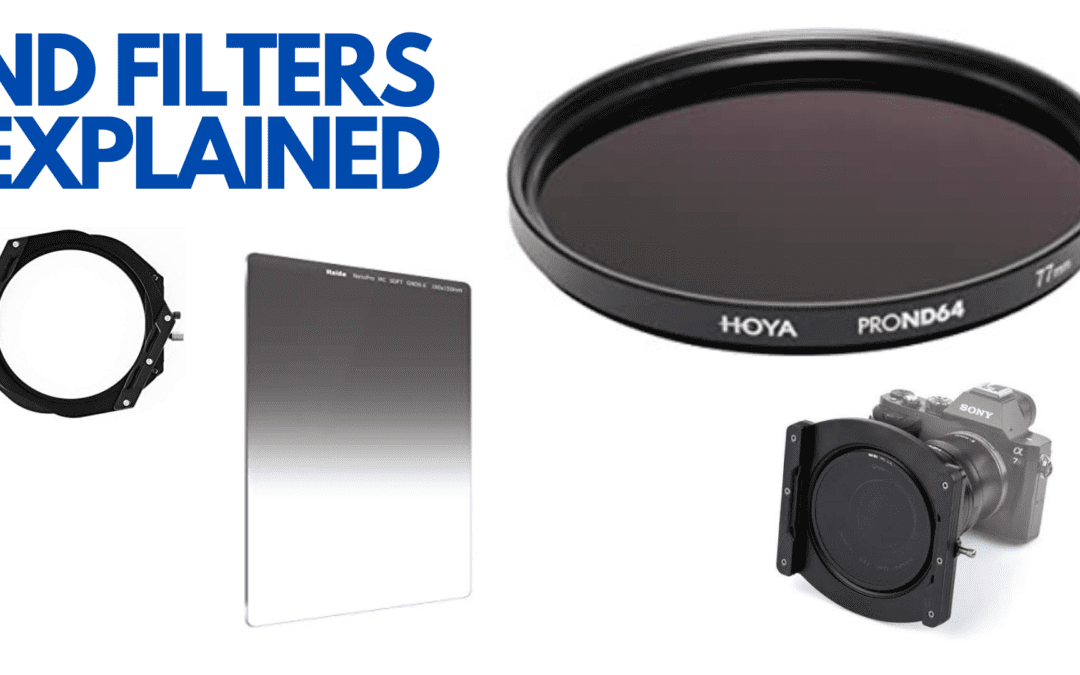In this article, I’ll be attempting to answer some questions about ND filters. What are ND filters? How to use an ND filter? When should you use an ND filter? And many other more. Let’s start off with the first and most basic question.
What are ND filters?
An ND (Neutral Density) filter is a filter that is placed in front of a lens or in front of a sensor to reduce the amount of light. Basically, it is like putting sunglasses on your camera or lens. This might seem a little strange because most of the time, having a lot of light is generally considered a good thing.
The exposure triangle (which is made up of ISO, Aperture and Shutter speed) gives you the ability to reduce the amount of light that comes into the camera. These components are very effective but they have limitations that we cannot exceed. When you reach these limitations, you have to use alternate methods to reduce the light. One of these is to use an ND filter.
ND filters really have two jobs. The first one is to reduce the amount of light it lets through the filter. The second is to do this by not introducing a color distortion. Think about when you put on sunglasses. Most sunglasses will have a tint to them. This is fine for sunglasses but not when you are trying to capture an image. Essentially you want your filter to be as neutral as possible. Generally speaking, when it comes to filters, you get what you pay for. I’ve purchased generic ND filters of eBay only to find that they add a horrible green or magenta shift to my photos and they reduce the sharpness of the photos so much that I just won’t use them. These are limitations with the manufacturing process and the quality of the glass. Having said that, there are some great affordable options that perform really well. Even the top of the line filters will introduce some color shift that can be edited out using applications such as Lightroom and Photoshop.
So why would you want to use an ND filter? Most of the time, there are two main reasons to use an ND filter.
- Long exposures
- Depth of field
Firstly, if you are trying to do some long exposure photography where you want to smooth out motion or capture light trails. This allows you to keep the shutter open for a longer period of time to capture movement while not blowing out the image.

Long exposure
The second is to allow you to open up the lens for a very shallow depth of field when in a very brightly lit scene. There are cases where even 1/8000th of a second is not enough and so you can introduce an ND filter to cut the amount of light coming in.

Shallow depth of field
If you are recording video, this is a very common way to reduce the amount of light as the shutter is normally set to something light 1/48th of a second to produce a cinematic feel. In fact, most professional video cameras are fitted with internal ND filters in the camera itself. For the rest of this article though, I will be concentrating on photography only.
How to use an ND filter? Using an ND filter is really quite easy. The ND filter is fitted on the camera by using one of the two systems available today.
The first one is the screw-on type. This is fitted exactly The same way as every other filter available. It is a round filter it is screwed on to the end of your lens. If you look closely at the front end of your lens, you will see that it has some threads where you can screw the filter onto. This is probably the easiest way to fit an ND filter. The main consideration when purchasing and ND filter for your lens, is to make sure that you purchased the correct size. In every camera lens, there is some writing around the outside of the front element of the lens. See below.

A 77mm diameter lens
This information tells you the diameter of the lens. You just need to make sure that your ND filter is the correct size so that it fits onto your lens. Once the filter is fitted, you’re ready to go. Now, if you are using a DSLR camera, you will notice when you look through the viewfinder, that the image will be much darker. This is because in a DSLR the image that you can see through the viewfinder is coming straight through the lens which now has your ND filter fitted to it. If you are using a mirrorless camera you won’t really notice a difference when looking through the viewfinder because the camera can make up for this loss of light by boosting the image through your electronic viewfinder. This is one of the advantages of using an ND filter with a mirrorless camera.
One of the negatives when using a screw-on type filter is that you may need to purchase different size filters to fit different size lenses. One way to get around this is to get step up and step down adapters. These are basically adapters that attached to the filter so that you can use it on smaller lenses. If you are going to be using this system, I recommend you buy an ND filter to fit your largest lens. This way, you can attach that filter to all of your smaller lenses. If your filter is smaller than the lens you are trying to fit it on to, you will see the edges of the filter in your photograph. This is why you want to get the largest filter possible so that you don’t run into this problem. Alternatively, you can buy a filter for every one of your lenses but this can get expensive.
The second system uses an adapter it is mounted to the front of the lens that allows you to slide in multiple filters. This system looks more cumbersome than it actually is. You start off by attaching a mounting ring on all of your lenses. This mounting ring allows you to attach and detach the filter holder quickly and easily onto the lens.

Nisi Filter holder

Filer holder mounted on the camera
The filters that are used in this system are square or rectangular and tend to be larger than the circular ones. Generally speaking, they start at 100mm wide. The filters slide into the filter holder and usually had multiple slots so that you can use multiple filters at the same time. This is my preferred filter mounting system but there are some drawbacks. The lens holder is not a secure as the screwing type so if you’re walking around with a camera it is not ideal as it can come off. Because you can insert more than one filter at a time you can get combinations that are difficult to get with the screw-on type. For example, you could have an ND filter and also a polarising filter at the same time and because the philtres are much larger than the lenses you won’t get the vignette that is often caused by the smaller filters.
In conclusion, I would recommend that you have a combination of both systems If you can afford it. Otherwise, I would go with the square filters. It will give you the most flexibility out of the two different systems and the mounting rings for the lenses are inexpensive to the point that you could have one on every lens fitted permanently. As always, if you have any comments or questions on anything I’ve mentioned in this article, please leave me a comment. I would love to hear from you. See below for the list of ND filters I own.

